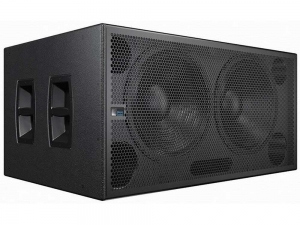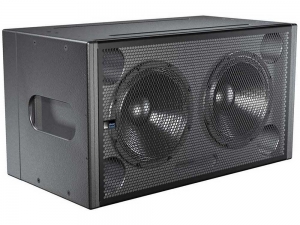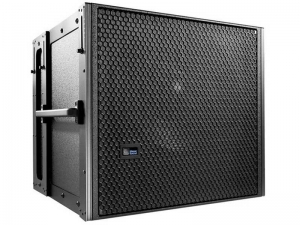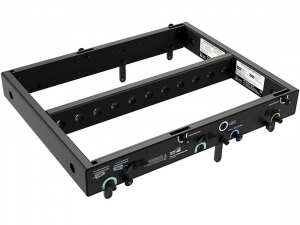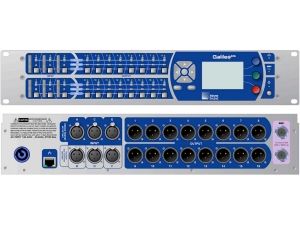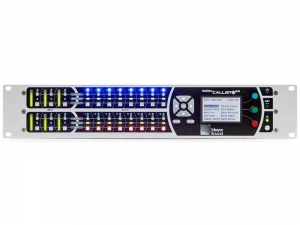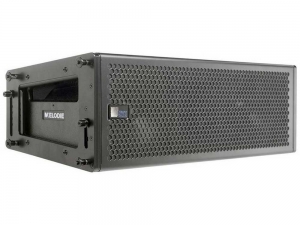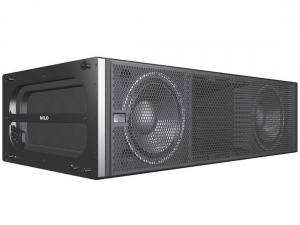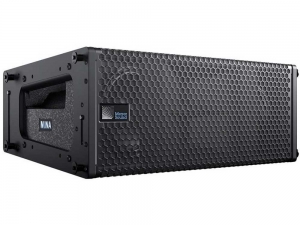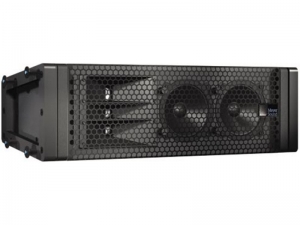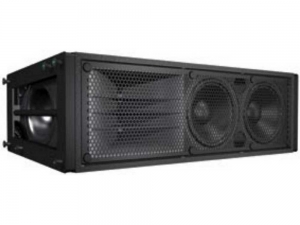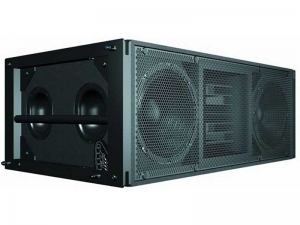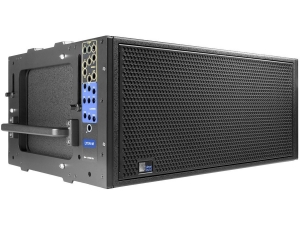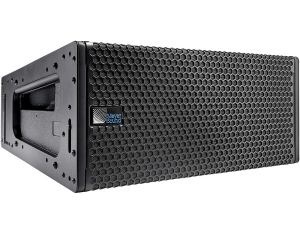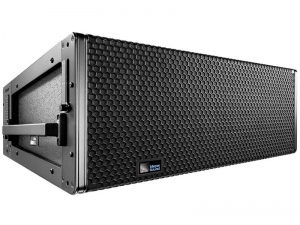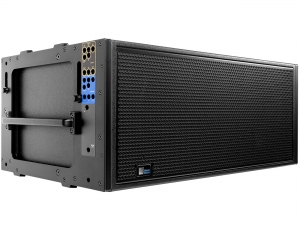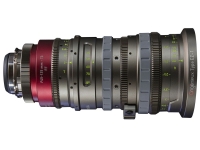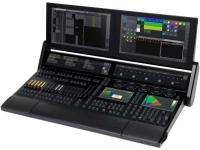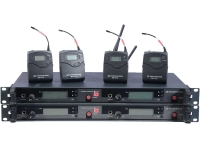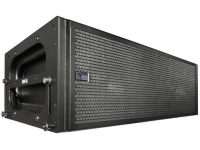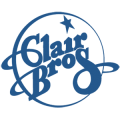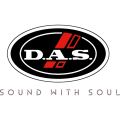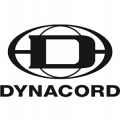ABOUT THE PRODUCT
ABOUT THE MANUFACTURER
GLOSSARY
MICA : Compact High-Power Curvilinear Array Loudspeaker
MICA is a self-powered, three-way loudspeaker designed for vertical curvilinear arraying. A member of the MILO family of high-power curvilinear array loudspeakers, the MICA loudspeaker is ideal for applications that do not require quite as much power and throw distance as MILO and where weight and size is a concern. The MICA compact highpower curvilinear array loudspeaker is equally applicable in a wide variety of applications such as touring, rental and fixed installations. MICA provides an excellent complement to a MILO main system for tours that are playing a variety of venues, being used as sidefills for large arenas and sheds and as the main system for smaller venues.
The loudspeaker provides very high acoustic output, with a single MICA producing a peak output of 138 dB SPL at one meter. High output combines with exceptionally flat phase and frequency response over a wide operating range of 60 Hz to 18 kHz. MICA’s frequency response, with its extended high-frequency characteristics, is quite compatible with MILO in applications where both loudspeaker types are used.
The MICA low/low-mid section features two high-power, neodymium magnet 10-inch cone drivers with 2-inch voice coils, especially designed for the power capability of the system. Both drivers are housed in separate vented enclosures within the loudspeaker, located on the left and right sides. The two high-power 10-inch drivers work in tandem at lower frequencies to take advantage of their combined acoustic output, while one of the drivers rolls off before the crossover frequency to maintain optimal polar and frequency response.
The high-frequency section — at the center between the two cone drivers — consists of two neodymium magnet compression drivers with 3-inch diaphragms and 1.2-inch exits. These newly designed drivers are seamlessly combined through a custom, patented Meyer Sound REM ribbon emulation manifold, coupled to a 100-degree horizontal constantdirectivity horn. This horn’s controlled, very narrow vertical dispersion is ideally suited for use in curvilinear arrays, allowing minimal destructive interaction in the high frequencies between adjacent enclosures. Compared to other methods, REM produces a smoothly controlled wavefront with less distortion and with the far higher output generated by compression drivers.
All four MICA transducers are designed and manufactured in-house, and are driven by an integral, four-channel class AB/H amplifier that provides 3020 watts of total output power (6000 watts peak). The integrated amplifier/processing circuitry includes TruPower limiting to protect the drivers and hold long-term power compression to less than 1 dB. The field-replaceable electronics module incorporates Meyer Sound’s Intelligent AC power supply, which automatically adjusts for any line voltage world-wide and provides both soft turn-on and transient protection. The MICA loudspeaker comes with the RMS remote monitoring system interface installed. RMS offers comprehensive monitoring of system parameters on a Windows-based network.
MICA systems may be deployed in either flown or ground-stacked configurations. Newly designed QuickFly rigging hardware uses captive GuideALinks contained within recessed guides in the front and rear corners of the cabinet. A slot and convenient pinned handle allow the link to be moved and pinned for arraying or storage. The rear link permits 10 splay angles between 0 and 6 degrees (in 0.5-degree increments from 0 to 3 degrees, and in 1-degree increments from 3 to 6 degrees), the two-position front link may be set to add 7 degrees, adjusting coverage to miss balcony fronts and other architectural obstacles. The rigid connections allow easy adjustment of array tilt, and often eliminate the need for a pullback strap in flown configurations. A single flown array can include up to 22 MICA loudspeakers with a 7:1 safety factor, and 25 loudspeakers with a 5:1 safety factor.*
Options for MICA include a weather-protected version with a rain hood to safeguard the electronics, and custom color finishes. Top and transition grids, a caster frame for transporting stacks of multiple units, and protective covers are available.
*Restrictions apply, see the MG-MICA Assembly Guide for more information
Features & Benefits
- Very high power-to-size ratio
- Exceptional fidelity and transient response for intelligibility and highimpact
- Seamless integration with MILO
- Wide and even horizontal coverage pattern across the full bandwidth
- QuickFly rigging system with new captive GuideALinks simplifies use in flown or ground-stacked arrays
Applications
- Performing arts centers, theatres, churches, and other fixed installations
- Touring sound reinforcement for midsized venues
- Sidefill hangs with MILO in very large venues
Professional used lighting equipment.| Professional second hand lighting equipment.| Professional pre owned lighting equipment.
Professional used audio equipment.| Professional second hand audio equipment.| Professional pre owned audio equipment.
Second hand audio gear. | Second hand lighting.
Pro audio equipment, second hand amplifiers, DJ, second hand sound systems, second hand Microphones, second hand Media Players.
Outdoor & Indoor LED screens for sale, LED mobile truck.
Light trussing, Gebrauchte Veranstaltungstechnik, used stage equipment Stage & Theatre lighting products.
Used Meyer Sound Laboratories
Meyer Sound Laboratories is an American company based in Berkeley, California that manufactures self-powered loudspeakers, multichannel audio show control systems, electroacoustic architecture, and audio analysis tools for the professional sound reinforcement, fixed installation, and sound recording industries.
The company’s emphasis on research and measurement has resulted in the issuance of dozens of patents, including for the now-standard trapezoidal loudspeaker cabinet shape. Meyer Sound has pioneered other technologies that have become standard in the audio industry, including: processor-controlled loudspeaker systems, self-powered loudspeakers,curvilinear arraying, cardioid subwoofers, and source independent measurement.
Meyer Sound has consistently involved itself with advanced research beyond that connected to immediate product development, sometimes in conjunction with arms of the University of California, Berkeley. Some of this research has resulted in unusual products such as their parabolic sound beam and sound field synthesis loudspeakers. Other projects, such as the spherical loudspeaker research underway by Meyer Sound and CNMAT (Center for New Music and Audio Technologies) at UC Berkeley are still in the stage of pure research.
Professional used lighting equipment.| Professional second hand lighting equipment.| Professional pre owned lighting equipment.
Professional used audio equipment.| Professional second hand audio equipment.| Professional pre owned audio equipment.
Second hand audio gear. | Second hand lighting.
Pro audio equipment, second hand amplifiers, DJ, second hand sound systems, second hand Microphones, second hand Media Players.
Outdoor & Indoor LED screens for sale, LED mobile truck.
Light trussing, Gebrauchte Veranstaltungstechnik, used stage equipment Stage & Theatre lighting products.
Efficiency Rating: Level of sound output measured at a prescribed distance with a standard input power. Efficiency rating standard is 1 watt (2.83V at 8 ohms) at 1 meter over a specified frequency range and is measured in decibels.
Equalization: Loosely, any type of relative frequency adjustment. Specifically, the process of changing the frequency balance of an electrical signal to alter the acoustical output.
Equalizer: A component designed to alter the frequency balance of an audio signal. Equalizers may be graphic, parametric, or a combination of both.
Fade: A gradual increase in audio, i.e. a fade-up, or a gradual decrease in audio, i.e. a fade-down.
Feedback: The transmission of current or voltage from the output of a device back to the input, where it interacts with the input signal to modify operation of the device. Feedback is positive when it’s in phase with the input and negative when it’s out of phase.
FM: Frequency Modulated.
Frequency: The number of cycles (vibrations) per second. In audio, audible frequencies commonly range from 20 to 20,000 cycles per second (Hz). In video, frequency is used to define the image resolution. Low-frequency video images depict large objects or images. Higher frequencies depict smaller objects (finer details.
Frequency Response: A measure of what frequencies can be reproduced and how accurately they are reproduced. A measurement of 20 to 20,000 Hz, 3dB means those frequencies between 20 and 20,000 Hz can be reproduced no more than 3 dB above or below a reference frequency level.
Full-Range: A speaker designed to reproduce the full range (20 Hz to 20 kHz) of audio frequencies.
Gain: Increase in level or amplitude.
Gooseneck: This refers to a microphone with a flexible neck that is most frequently attached to a podium or lectern. It is designed to allow the speaker to raise or lower the microphone to a suitable height.
Graphic Equalizer: A type of equalizer with sliding controls that creates a pattern representing a graph of the frequency-response changes. Raising sliders boosts the affected frequencies lowering sliders cuts (attenuates) the affected frequencies.
HDCP: High-Bandwidth Digital Content Protection. Created by Intel, HDCP is used with HDTV signals over DVI and HDMI connections and on D-Theater D-VHS recordings to prevent unauthorized duplication of copyright material.
HDR: Hard-Drive Recorder. Device that uses a computer hard drive to store compressed digital audio and video signals.
High Pass: A filter that passes high frequencies, and attenuates low frequencies. Same as low cut.
Hz: Hertz or cycles per second. Something that repeats a cycle once each second moves at a rate of 1 Hz.
Incue/Inq/In-Point: These words all refer to the initial few seconds of audio signifying the beginning of the production.
Integrated Amplifier: A combination preamp and amplifier.
Impedance: A measure of the impediment to the flow of alternating current, measured in ohms at a given frequency. Larger numbers mean higher resistance to current flow.
KHz: Kilohertz or one thousand Hz.
Lavaliere: A small microphone that attaches to clothing, allowing the speaker to have a hands-free presentation.
Line Array: A group of speakers that have been arrayed or "built up" in the vertical or horizontal plane, which allow for a highly consistent sound field. A Line Array is perfect for medium to large audiences.
Line-Level (Low-Level): A level of electrical signals too low to make the average speaker move sufficiently. Amplifiers receive line-level signals and amplify them to speaker level.
lockout: The final words of a segment used to signify the production’s conclusion.
Low Pass: A filter that lets low frequencies go through but doesn’t let high frequencies go through. Same as high cut.
MHz: Megahertz, or 1 million Hz.
Midbass: The middle of the bass part of the frequency range, from approximately 50 to 100 Hz (upper bass would be from 100 to 200 Hz). Also used as a term for loudspeaker drivers designed to reproduce both bass and midrange frequencies.
Midrange: The middle of the audio frequency range. Also used as a term for loudspeaker drivers designed to reproduce this range.
Mixer: This is the unit in which audio signals are directed from. A mixer provides for both mic and line input combinations while allowing you to control one or more outputs.
MLP: Meridian Lossless Packing. Encoding format that is able to completely reconstruct the original signal at the receiving end. No information is lost or discarded, regardless of how trivial it might be. Used to encode six channels of high-resolution audio on DVD-A.
Mono: Monophonic sound. One channel.
MP3: MPEG-1 Audio Layer-3. Compression scheme used to transfer audio files via the Internet and store in portable players and digital audio servers.
Natural Sound (NATS): The nonverbal audio that occurs in a non-studio setting. NATS can be used to help characterize the setting.
Noise: An unwanted portion of a signal such as hiss, hum, whine, static, or buzzing.
Nonlinear Editing: Digital audio systems that allow for clips to be extracted without affecting the master recording.
Professional used lighting equipment.| Professional second hand lighting equipment.| Professional pre owned lighting equipment.
Professional used audio equipment.| Professional second hand audio equipment.| Professional pre owned audio equipment.
Second hand audio gear. | Second hand lighting.
Pro audio equipment, second hand amplifiers, DJ, second hand sound systems, second hand Microphones, second hand Media Players.
Outdoor & Indoor LED screens for sale, LED mobile truck.
Light trussing, Gebrauchte Veranstaltungstechnik, used stage equipment Stage & Theatre lighting products.

